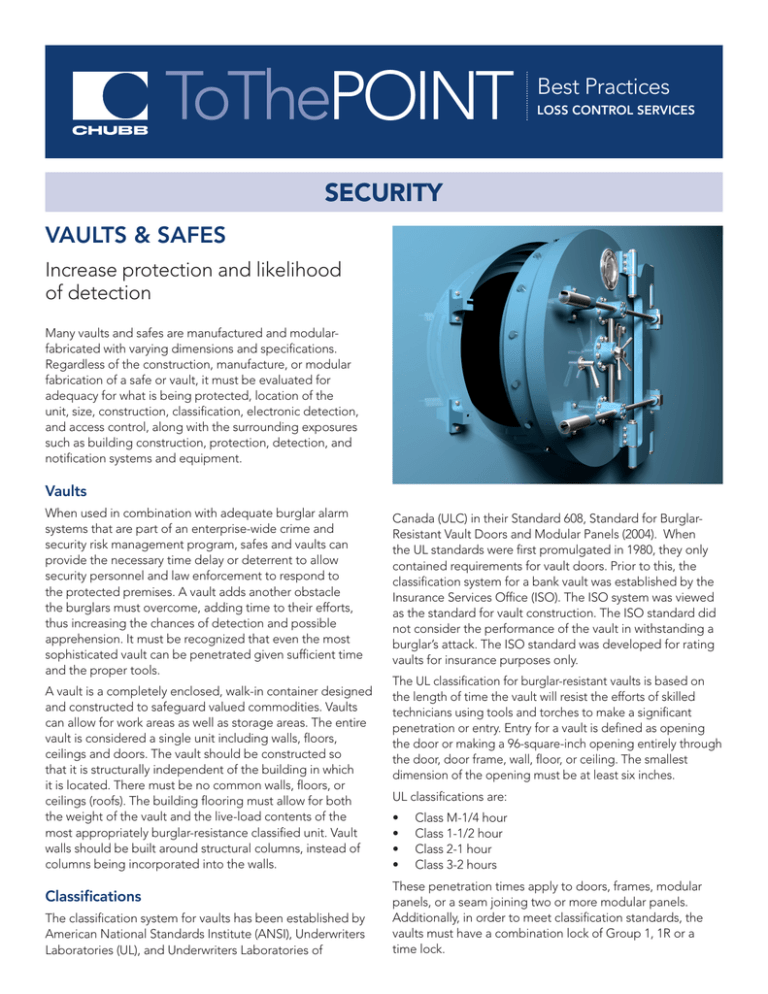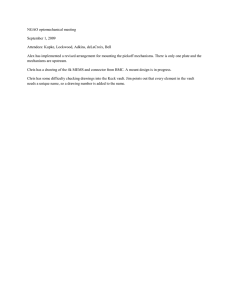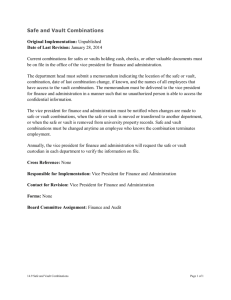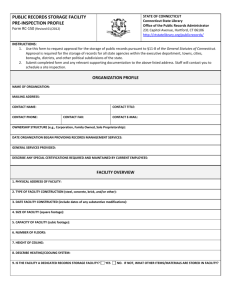ToThePOINT Best Practices
advertisement

ToThePOINT Best Practices LOSS CONTROL SERVICES SECURITY VAULTS & SAFES Increase protection and likelihood of detection Many vaults and safes are manufactured and modularfabricated with varying dimensions and specifications. Regardless of the construction, manufacture, or modular fabrication of a safe or vault, it must be evaluated for adequacy for what is being protected, location of the unit, size, construction, classification, electronic detection, and access control, along with the surrounding exposures such as building construction, protection, detection, and notification systems and equipment. Vaults When used in combination with adequate burglar alarm systems that are part of an enterprise-wide crime and security risk management program, safes and vaults can provide the necessary time delay or deterrent to allow security personnel and law enforcement to respond to the protected premises. A vault adds another obstacle the burglars must overcome, adding time to their efforts, thus increasing the chances of detection and possible apprehension. It must be recognized that even the most sophisticated vault can be penetrated given sufficient time and the proper tools. A vault is a completely enclosed, walk-in container designed and constructed to safeguard valued commodities. Vaults can allow for work areas as well as storage areas. The entire vault is considered a single unit including walls, floors, ceilings and doors. The vault should be constructed so that it is structurally independent of the building in which it is located. There must be no common walls, floors, or ceilings (roofs). The building flooring must allow for both the weight of the vault and the live-load contents of the most appropriately burglar-resistance classified unit. Vault walls should be built around structural columns, instead of columns being incorporated into the walls. Classifications The classification system for vaults has been established by American National Standards Institute (ANSI), Underwriters Laboratories (UL), and Underwriters Laboratories of Canada (ULC) in their Standard 608, Standard for BurglarResistant Vault Doors and Modular Panels (2004). When the UL standards were first promulgated in 1980, they only contained requirements for vault doors. Prior to this, the classification system for a bank vault was established by the Insurance Services Office (ISO). The ISO system was viewed as the standard for vault construction. The ISO standard did not consider the performance of the vault in withstanding a burglar’s attack. The ISO standard was developed for rating vaults for insurance purposes only. The UL classification for burglar-resistant vaults is based on the length of time the vault will resist the efforts of skilled technicians using tools and torches to make a significant penetration or entry. Entry for a vault is defined as opening the door or making a 96-square-inch opening entirely through the door, door frame, wall, floor, or ceiling. The smallest dimension of the opening must be at least six inches. UL classifications are: • • • • Class M-1/4 hour Class 1-1/2 hour Class 2-1 hour Class 3-2 hours These penetration times apply to doors, frames, modular panels, or a seam joining two or more modular panels. Additionally, in order to meet classification standards, the vaults must have a combination lock of Group 1, 1R or a time lock. Other considerations in the classification of vaults include: • Emergency and normal ventilation systems, as listed by UL. • Lighting must conform to the National Electric Code (NEC). All conduits leading into the vault and piercing the ceiling, wall, or floor must not exceed 1½ inches in diameter and must not form a direct path through the wall or floor. This requires that a path be offset at least once at a 90º angle. relocking devices. Since the resistance to attack is through the use of steel and alloys, these safes are not intended to protect their contents from heat, as the metals are usually good thermal conductors. Fire-resistant safes are designed to protect valuable papers, electronic documents or records from heat damage. When an attempt is made to drill or torch the locking bolt to the combination lock, the re-locking device is automatically triggered to lock the bolt work, preventing the bolt work from being retracted. Expert assistance is required to open the safe after such an occurrence. Vault Construction Types Alarm Protection Modular Panels—These panels are of composite materials that resist tool and torch attacks, high-strength concrete with special reinforcing, and lightweight, laminated panels. An advantage to a vault fabricated with modular panels is that it can be dismantled and relocated if necessary. UL lists “partial” and “complete” alarms for vaults and safes. The “partial” system protects (with recognized devices) the outer door and door lock of the vault or safe. The “complete” system protects the top, bottom, all sides, and outer doors of the vault or safe. Reinforced Concrete—These vault walls are known as generic walls and there are a variety of thickness options including 9” (Class M), 12” (Class 1), 18” (Class 2), and 27” (Class 3). They must have reinforcing bars forming grids no larger than four inches on center. The evaluation of the adequacy of alarm protection must include the type and value of the commodity in the vault or safe, access controls, and the location of the unit in the protected premise and related protective systems. “Partial” alarm protection provides minimal protection on a vault or safe. As values exceed $3M USD, consideration should be given to having two UL-certified alarm systems protecting the vault or safe. Each of these systems must have line security and not be connected to the same monitoring alarm company. A typical arrangement has a building perimeter alarm and the “partial” alarm system installed by the same central station, as well as a “complete” alarm installed by a different UL-listed central station. Reinforced Concrete Block—Vault walls can be constructed of 8-inch, 12-inch, or 16-inch thick concrete blocks filled with concrete, reinforced with steel rods, and lined on the inside with steel plating. This method is less expensive and lighter than a reinforced concrete wall. However, no equivalent rating has been developed by UL. These reinforced concrete block vaults, when lined with steel, are often referred to as a jeweler’s special. Laminated Panels—A steel-ply system consisting of two layers of low-alloy steel with thick, exterior-grade plywood in between. Frequent application of laminated panels can be retrofitted onto walls, ceiling, and floor of a vault lacking burglary resistance classification. Depending on the tools, penetration resistance is approximately 15 minutes. Steel Lining or Plates—Steel lining or plating alone is unacceptable as a burglary-resistant vault wall construction. UL tests have shown that steel lining alone is very vulnerable to attack, particularly by oxyacetylene torch, with a resistance of less than four minutes. Safes A burglary-resistant safe is designed to provide protection for valuable commodities from unauthorized access. This protection is achieved by the use of steel and/or metal alloys in the body and door of the safe combined with locking and Vault, safes, and alarm protection are not the only aspects in the overall evaluation of the risk. Evaluation should include such considerations as guard service, type of operation, working hours, commodity demand, physical protection, additional alarm systems, and administrative controls on inventory and personnel, each a component of an enterprise-wide evaluation. Resources ANSI / UL and ULC Standard 608 Standard for Burglar-Resistant Vault Doors and Modular Panels Central Station Alarm Association A Practical Guide to Central Station Burglar Alarm Systems NFPA 70 National Electric Code NFPA 730 Guide for Premises Security UL 687 Standard for Burglary-Resistant Safes Chubb Group of Insurance Companies | www.chubb.com This document is advisory in nature. It is offered as a resource to be used together with your professional insurance advisors in maintaining a loss prevention program. Our evaluations, reports, and recommendations are made solely to assist the insurer in underwriting and loss control. Evaluation for any hazard or condition does not imply that it is covered under any policy. No liability is assumed by the information contained in this document. Chubb refers to the insurers of the Chubb Group of Insurance Companies. Form 09-10-0530 (Rev. 1/13)


